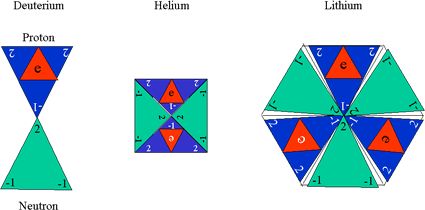At the end of the previous entry, I promised to show how the neutron is the inverse of the proton. Actually, the LST community’s abstract concept of quantum “isospin” treats them as inverses, even though they differ by charge and by a very small difference in mass.
Also, the LST’s concept of quarks provides a sense of the inverse composition of proton and neutron, since the proton consists of two up quarks and a down quark, while the neutron consists of two down quarks and an up quark.
In our case, since the difference between the quarks consists of differences between their three sets of discrete, inverse, oscillations, the preons forming them, we can quantify this net inverse relation by employing a schematic diagram to represent the combinations.
The up quark has two sets of 3D oscillations with one more TUDR (2) than SUDR (1), together with one balanced set consisting of one SUDR and one TUDR. Hence, we can replace it with the number 2, because 1+1+0 = 2.
The down quark consists of two balanced sets and one unbalanced set with two SUDRs and one TUDR. We can therefore replace it with the number -1, because -1+0+0 = -1. Consequently, representing the proton with two 2s, for its two up quarks, and one -1, for its one down quark, placed at the three vertices of a triangle, we get 2, 2, -1, while doing the same thing for the three quarks of the neutron will give us a -1, -1, 2 pattern, which is the inverse pattern of the proton.
Using the same procedure with the electron, which has three unbalanced sets of 3D oscillations, all unbalanced to the SUDR (red) side, we get -1 + -1 + -1 = -3. Thus, the electron “neutralizes” the excess positive sum of the proton’s quark numbers ((2+2+(-1)) + ((-1)+(-1)+(-1)) = 0), while, of course, the sum of the neutron’s quark numbers is already 0.
Thus, it all comes together nicely in the schematic of triangles, which represents the net oscillations, after a fashion, as shown graphically here.
This development was so encouraging when it first emerged two and half years ago, that I was sure we would be able to continue it and reach our goal of tying our preon version of the standard model of particle physics, with our 4n2 version of the periodic table, the Wheel of Motion.
This would be an important achievement, since it would be the first time in history that an alternative to the LST community’s quantum mechanics and its wave equation, based on the concept of rotation, would have emerged.
Alas, however, crossing the bridge between the preon model and the Wheel of Motion has been more difficult than imagined. As described here, it appears that we have to follow Hamilton’s work with rotation and accept the fact that the number four plays an essential role in the combining of our preons to form the correct series of elements in the Wheel of Motion.
While it’s true that the inverse numbers in the schematics of the proton and neutron work nicely to combine them into combos that have interesting properties, including spin, the Pauli Exclusion principle and the concentration of numbers at the center of the combo, with numbers spread out at the periphery, the fact is, there is no mechanism for limiting the preon numbers, in the same way that the correspondence with vectorial motion in rotations limits the quantum numbers. It’s the limit that we are lacking. The question boils down to this: “What is the ‘n’ in the “4n2” relationship of the Wheel of Motion?
Schematically, we can build an atom by placing the proton and neutron together as shown for deuterium, helium and lithium in figure 1, below:

Figure 1. Building Atoms from Preons
As can be seen from figure 1, when represented with the three vertices of a triangle, schematically, the up and down quark and electron preons, form combinations that we can identify as hydrogen (the proton and electron combo without a neutron (not shown separately)), as deuterium (one hydrogen and one neutron), as helium (two hydrogen and two neutrons) and as lithium (three hydrogen and three neutrons). The electron is shown schematically in two states: The black letter “e” represents one state (on top of the proton triangle), while the white letter “e” represents the other state (on the bottom of the proton triangle).
While this enables us to find parallels with the four quantum numbers schematically, if not physically, the problem is there is no variable ‘n’ that can be identified that corresponds to the radius of an electron shell in the quantum mechanical model of the LST, the primary quantum number ‘n’ in the 2n2 relations of the periodic table.
This has driven me back to the beginning, to take another look at the fundamental 3D oscillations, the SUDRs and TUDRs. While we have only considered one family of the standard model’s quarks and leptons, it has always been evident that we could probably derive the second and third families by adding to the number of SUDRs and TUDRs in the preons, while maintaining their ratios. It was left at that, because it was assumed that connecting the Wheel to the preons was not related to the other families, and that part of the development could therefore be delayed, until later.
However, this appears to have been an error. I’ll explain why next time.